公示语英译汉
- 格式:doc
- 大小:41.50 KB
- 文档页数:3
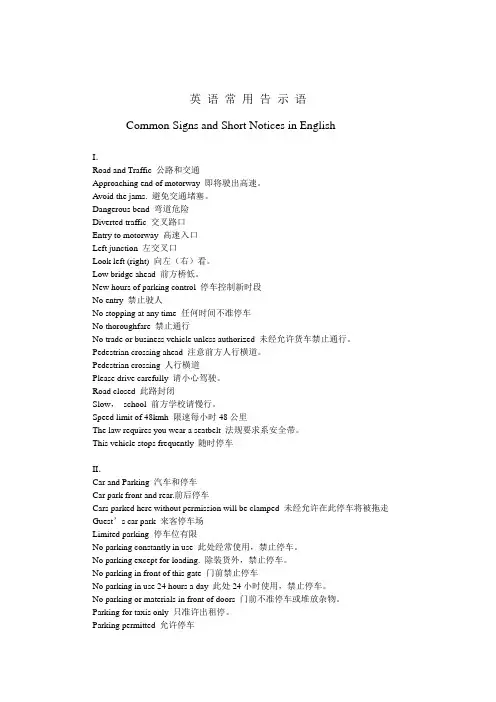
英语常用告示语Common Signs and Short Notices in EnglishI.Road and Traffic 公路和交通Approaching end of motorway 即将驶出高速。
Avoid the jams. 避免交通堵塞。
Dangerous bend 弯道危险Diverted traffic 交叉路口Entry to motorway 高速入口Left junction 左交叉口Look left (right) 向左(右)看。
Low bridge ahead 前方桥低。
New hours of parking control 停车控制新时段No entry 禁止驶人No stopping at any time 任何时间不准停车No thoroughfare 禁止通行No trade or business vehicle unless authorized 未经允许货车禁止通行。
Pedestrian crossing ahead 注意前方人行横道。
Pedestrian crossing 人行横道Please drive carefully 请小心驾驶。
Road closed 此路封闭Slow,school 前方学校请慢行。
Speed limit of 48kmh 限速每小时48公里The law requires you wear a seatbelt 法规要求系安全带。
This vehicle stops frequently 随时停车II.Car and Parking 汽车和停车Car park front and rear.前后停车Cars parked here without permission will be clamped 未经允许在此停车将被拖走Guest’s car park 来客停车场Limited parking 停车位有限No parking constantly in use 此处经常使用,禁止停车。
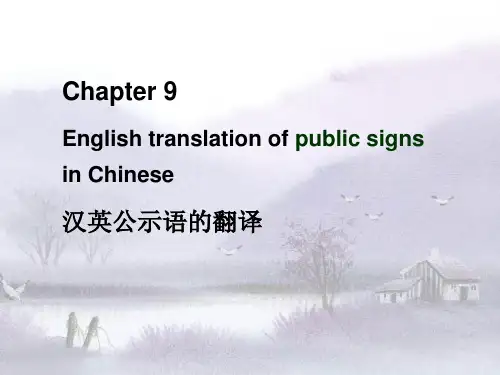
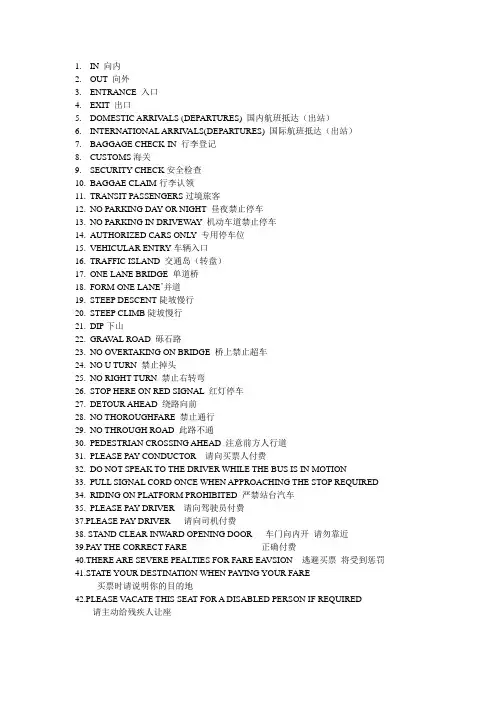
1.IN 向内2.OUT 向外3.ENTRANCE 入口4.EXIT 出口5.DOMESTIC ARRIV ALS (DEPARTURES) 国内航班抵达(出站)6.INTERNATIONAL ARRIV ALS(DEPARTURES) 国际航班抵达(出站)7.BAGGAGE CHECK-IN 行李登记8.CUSTOMS海关9.SECURITY CHECK安全检查10.BAGGAE CLAIM行李认领11.TRANSIT PASSENGERS过境旅客12.NO PARKING DAY OR NIGHT 昼夜禁止停车13.NO PARKING IN DRIVEW AY 机动车道禁止停车14.AUTHORIZED CARS ONL Y 专用停车位15.VEHICULAR ENTRY车辆入口16.TRAFFIC ISLAND 交通岛(转盘)17.ONE LANE BRIDGE 单道桥18.FORM ONE LANE’并道19.STEEP DESCENT陡坡慢行20.STEEP CLIMB陡坡慢行21.DIP下山22.GRA V AL ROAD 砾石路23.NO OVERTAKING ON BRIDGE 桥上禁止超车24.NO U TURN 禁止掉头25.NO RIGHT TURN 禁止右转弯26.STOP HERE ON RED SIGNAL 红灯停车27.DETOUR AHEAD 绕路向前28.NO THOROUGHFARE 禁止通行29.NO THROUGH ROAD 此路不通30.PEDESTRIAN CROSSING AHEAD 注意前方人行道31.PLEASE PAY CONDUCTOR 请向买票人付费32.DO NOT SPEAK TO THE DRIVER WHILE THE BUS IS IN MOTION33.PULL SIGNAL CORD ONCE WHEN APPROACHING THE STOP REQUIRED34.RIDING ON PLATFORM PROHIBITED 严禁站台汽车35.PLEASE PAY DRIVER 请向驾驶员付费37.PLEASE PAY DRIVER 请向司机付费38. STAND CLEAR INW ARD OPENING DOOR 车门向内开请勿靠近39.PAY THE CORRECT FARE 正确付费40.THERE ARE SEVERE PEALTIES FOR FARE EA VSION 逃避买票将受到惩罚41.STA TE YOUR DESTINA TION WHEN PAYING YOUR FARE买票时请说明你的目的地42.PLEASE VACA TE THIS SEA T FOR A DISABLED PERSON IF REQUIRED请主动给残疾人让座42BOTTLE SHOP 瓶装酒经销店43BOTTLE SERVICE 瓶装酒经销店44BOTTLE SALES 瓶装酒经销店45LIQUOR SHOP 白酒商店46DOLLAR BOOKSHOP 一元书店47DISPOSAL SHOP 清仓处理店48DUTY FREE SHOP 免税商店49USED CAR DEALER 二手车经销商50PREOWNED CAR BROKER 旧车转让中间商51X GOERMENT CARS FOR SALE52BUTCHER 肉店53BUTCHERY 肉店54REAL ESTATE AGENTS 房产中介55PAWN BROKER 典当行56MONEY LENDER 放款人57HAIR SALON 发廊58HAIRDRESSING SALON 美发厅59BARBER 理发店60HAIR STYLISTS 美发屋61BEAUTY PARLOR 美容院62WATCHMAKER: QUALITY REPAIR 钟表精修63FUNERAL DIRECTORS 殡仪员64MOTOR FUNERALS 丧葬车出租店65DRUM CITY—EVERYTHING MUSICAL 鼓城乐器大全66LOCKSMITH 锁店67FURNITURE CENTRE 家具城68DOG SHOP 养狗用品商店69TOY FISHERIES 渔具店70AUTO SERVICES 汽车维修71QUALITY BODY BEATING 车身精修72SALE PRICE 特价73CRAZY PRICE 疯狂大减价74TERRIFIC VALUE 超值商品75SPECIAL BUY 大甩卖76INSTANT REPAIR 立等可取77REPAIR WHILE U WAIT 即时修理立等可取78SAME DAY SERVICE 当日维修服务79HOURS FOR OPENNG AND CLOSING 开放时间80DISCOUNT 折扣店81NOT FOR SALE 非卖品82SELF-SERVICE 自助83OPEN 7 DAYS A WEEK 每周七天开放84CUSTOMERS PLEASE REFRAIN FROM ENTERING THIS AREA 顾客请止步85NOT FOOD OR DRINKS TO BE BROUGHT IN SHOP 请不要把饮食带入商店86UNATTENEDED CHILDREN NOT ALLOWED IN SHOP 无人照顾儿童谢绝进入商场87COME ON IN 顾客请进88COME ON OUT 请出来89COME ON DOWN 顾客请上楼90FEEL FREE TO BROWSE AROUNDYOU’RE UNDER NO OBLIGATION TO BUY 只许参观浏览不许购买94. THANK YOUR FOR YOUR CUSTOM 感谢惠顾95. DO NOT LITTER无乱扔杂物97. PLEASE KEEP THIS SITE BEAUTIFUL 请保持清洁98. TAKE YOUR LITTER WITH YOU 请带走你的垃圾99. PULLTION IS A MENACE TO US ALL 污染对人人有害100. PLEASE DO NOT THROW PLASTIC AND PAPER RUBBISH INTO THIS RIVER.请勿往河里投掷垃圾101 FIRE CAN BE DANGEROUS 火灾危险102 PLEASE DON’T DROP LIGHTED CIGARETTES AND MA TCHES 禁止烟火103 NO RUNNING (ROUGH PLAY /SWEARING/CHEWING GUM/GLASS BOTTLES/DOGS OR ALCHOHOL) ALLOWED 请不要跑/大闹/骂人/吃口香糖/104 . PRIV ATE PROPERTY KEEP OUTTRESPASSERS WILL BE PROSECUTED 私人住宅请勿入内闯入者将法办105 THS AREA IS OPEN FOR INSPECTION ONL Y 此区在检查时开放106 PLEASE STOP请止步NO ENTRANCE禁止入内107 STAFFF ONL Y员工通道108 PRIV ATE 私人专用109 THE SALES SECTION STOPS HERE 非营业区110 ADMITTANCE TO THIS AREA IS PROHIBITED 禁止入内111 NO ADMITTANCE 闲人免进112 POSITIVELY NO ADMITTANCE 严禁入内113 TAKE YOUR HANDS OFF THE RAIL 请勿扶栏杆114 THANK YOU FOR NOT SMOKING 请勿吸烟115 DO NOT PROCEED BEYONG RAIL 请勿翻越栏杆116 ANY DAMAGES OR BREAKEAGES MUST BE PAID FOR 损坏东西必须赔偿117 IF IT BREAKS WE CONSIDER IT SOLD TO YOU 若有破损请负责赔偿118 LOOK WITH YOUR EYES PLEASE DON’T TOUCH 请勿动手触摸119 PHOTOGRAPHY INSIDE OLD GOVERNMENT HOUSE NOT PERMITTED 不准在古旧的政府大楼内拍照120 NO ENTRY BY THIS DOOR 请勿走此门121 PLEASE DO NOT LEA VE YOUR BELONGINGS HERE. 请勿放置个人物品122 THE MAAGEMENT RESERVES THE RIGHT TO REFUSE ENTRY 管理人员有权谢绝入内123PLEASE PUT ALL CARDS IN SHUTE SIT DOWN UNTIL CALLED 请用病例排队124NEXT TELLER PLEASE 请到其他窗口办理125ISSUE OF LOANS 发放贷款126RETURN OF LOANS 借款的偿付。
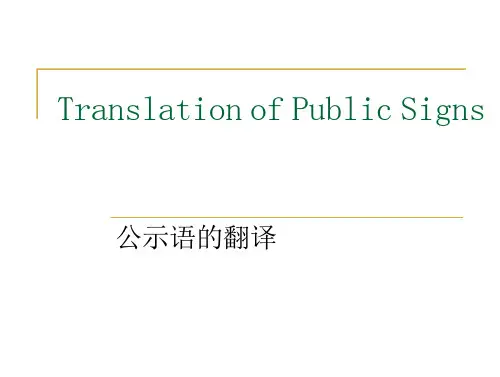
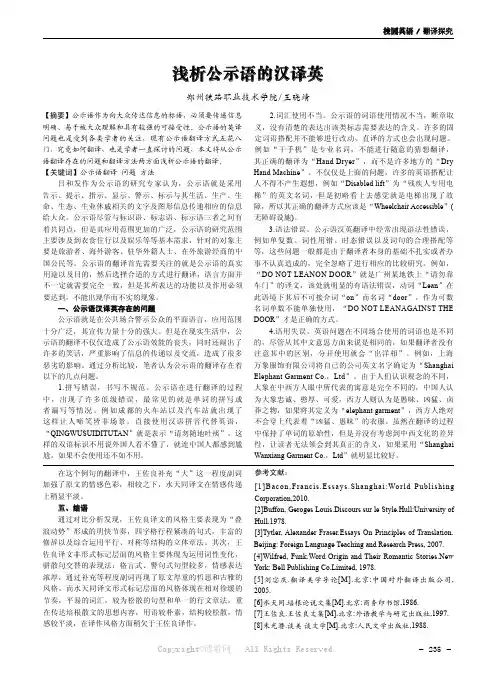
校园英语 /浅析公示语的汉译英郑州铁路职业技术学院/王晓靖【摘要】公示语作为向大众传达信息的标语,必须要传递信息明确、易于被大众理解和具有较强的可接受性。
公示语的英译问题也是受到各类学者的关注,现有公示语翻译方式五花八门,究竟如何翻译,也是学者一直探讨的问题,本文将从公示语翻译存在的问题和翻译方法两方面浅析公示语的翻译。
【关键词】公示语翻译 问题 方法吕和发作为公示语的研究专家认为,公示语就是采用告示、提示、指示、显示、警示、标示与其生活、生产、生命、生态、生业休戚相关的文字及图形信息传递相应的信息给大众。
公示语尽管与标识语、标志语、标示语三者之间有着共同点,但是其应用范围更加的广泛,公示语的研究范围主要涉及到衣食住行以及娱乐等等基本需求,针对的对象主要是旅游者、海外游客、驻华外籍人士、在外旅游经商的中国公民等。
公示语的翻译首先需要关注的就是公示语的真实用途以及目的,然后选择合适的方式进行翻译,语言方面并不一定就需要完全一致,但是其所表达的功能以及作用必须要达到,不能出现华而不实的现象。
一、公示语汉译英存在的问题公示语就是在公共场合警示公众的平面语言,应用范围十分广泛,其宣传力量十分的强大。
但是在现实生活中,公示语的翻译不仅仅造成了公示语效能的丧失,同时还闹出了许多的笑话,严重影响了信息的传递以及交流,造成了很多恶劣的影响。
通过分析比较,笔者认为公示语的翻译存在着以下的几点问题。
1.拼写错误,书写不规范。
公示语在进行翻译的过程中,出现了许多低级错误,最常见的就是单词的拼写或者漏写等情况。
例如成都的火车站以及汽车站就出现了这样让人啼笑皆非场景,直接使用汉语拼音代替英语,“QINGWUSUIDITUTAN”就是表示“请勿随地吐痰”,这样的双语标识不用说外国人看不懂了,就连中国人都感到尴尬,如果不会使用还不如不用。
2.词汇使用不当。
公示语的词语使用情况不当,断章取义,没有清楚的表达出该类标志需要表达的含义。
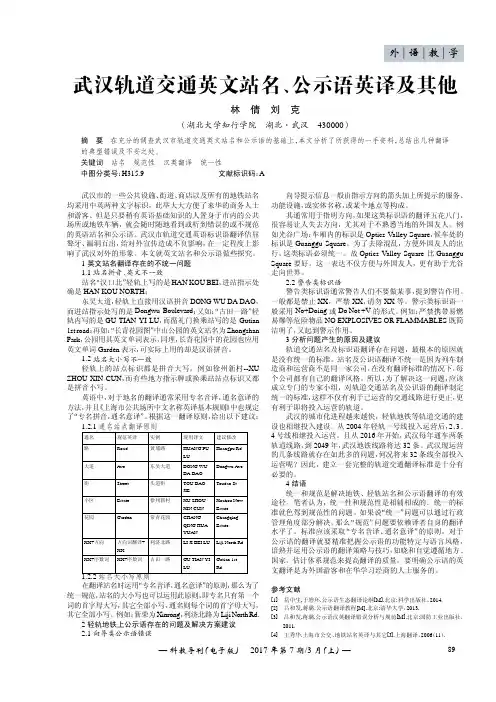
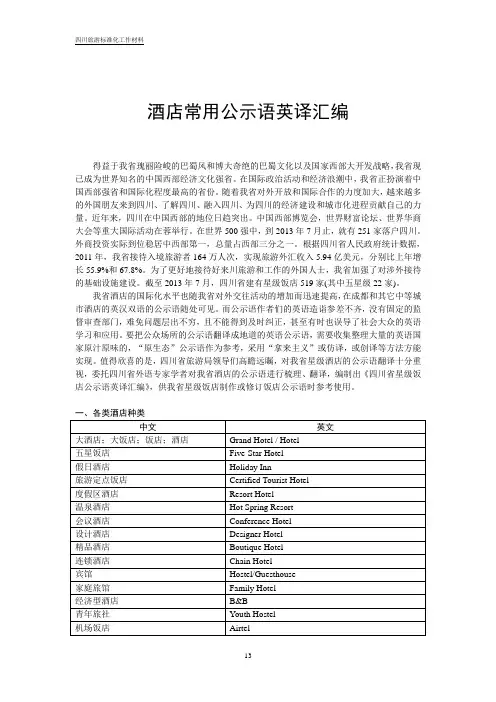
酒店常用公示语英译汇编得益于我省瑰丽险峻的巴蜀风和博大奇绝的巴蜀文化以及国家西部大开发战略,我省现已成为世界知名的中国西部经济文化强省。
在国际政治活动和经济浪潮中,我省正扮演着中国西部强省和国际化程度最高的省份。
随着我省对外开放和国际合作的力度加大,越来越多的外国朋友来到四川、了解四川、融入四川、为四川的经济建设和城市化进程贡献自己的力量。
近年来,四川在中国西部的地位日趋突出。
中国西部博览会,世界财富论坛、世界华商大会等重大国际活动在蓉举行。
在世界500强中,到2013年7月止,就有251家落户四川。
外商投资实际到位稳居中西部第一,总量占西部三分之一。
根据四川省人民政府统计数据,2011年,我省接待入境旅游者164万人次,实现旅游外汇收入5.94亿美元,分别比上年增长55.9%和67.8%。
为了更好地接待好来川旅游和工作的外国人士,我省加强了对涉外接待的基础设施建设。
截至2013年7月,四川省建有星级饭店519家(其中五星级22家)。
我省酒店的国际化水平也随我省对外交往活动的增加而迅速提高,在成都和其它中等城市酒店的英汉双语的公示语随处可见。
而公示语作者们的英语造诣参差不齐,没有固定的监督审查部门,难免问题层出不穷,且不能得到及时纠正,甚至有时也误导了社会大众的英语学习和应用。
要把公众场所的公示语翻译成地道的英语公示语,需要收集整理大量的英语国家原汁原味的,“原生态”公示语作为参考,采用“拿来主义”或仿译,或创译等方法方能实现。
值得欣喜的是,四川省旅游局领导们高瞻远瞩,对我省星级酒店的公示语翻译十分重视,委托四川省外语专家学者对我省酒店的公示语进行梳理、翻译,编制出《四川省星级饭店公示语英译汇编》,供我省星级饭店制作或修订饭店公示语时参考使用。
二、酒店外围及周边区域三、酒店大门区域七、酒店部门十、酒店人员称谓。
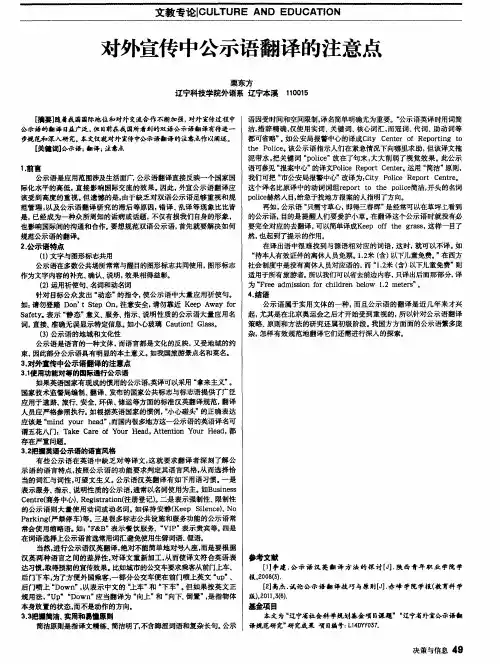
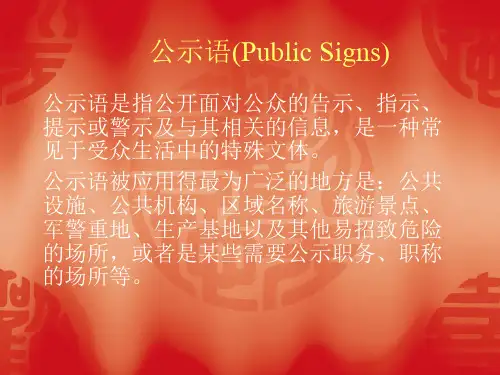
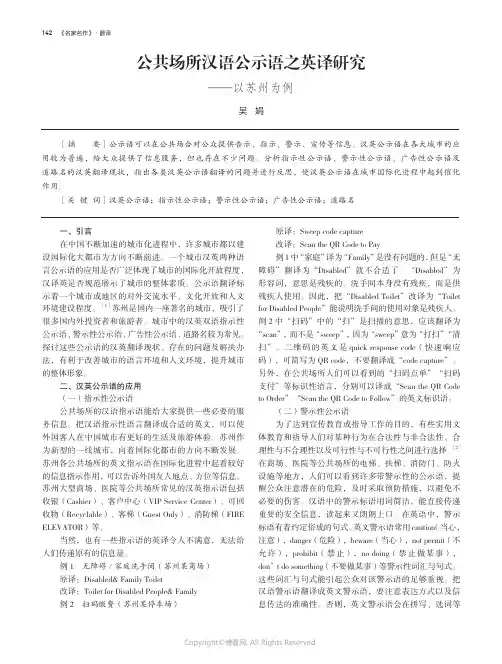
142《名家名作》·翻译一、引言在中国不断加速的城市化进程中,许多城市都以建设国际化大都市为方向不断前进。
一个城市汉英两种语言公示语的应用是否广泛体现了城市的国际化开放程度,汉译英是否规范展示了城市的整体素质。
公示语翻译标示着一个城市或地区的对外交流水平、文化开放和人文环境建设程度。
[1]苏州是国内一座著名的城市,吸引了很多国内外投资者和旅游者。
城市中的汉英双语指示性公示语、警示性公示语、广告性公示语、道路名较为常见。
探讨这些公示语的汉英翻译现状、存在的问题及解决办法,有利于改善城市的语言环境和人文环境,提升城市的整体形象。
二、汉英公示语的应用(一)指示性公示语公共场所的汉语指示语能给大家提供一些必要的服务信息。
把汉语指示性语言翻译成合适的英文,可以使外国客人在中国城市有更好的生活及旅游体验。
苏州作为新型的一线城市,向着国际化都市的方向不断发展。
苏州各公共场所的英文指示语在国际化进程中起着较好的信息指示作用,可以告诉外国友人地点、方位等信息。
苏州大型商场、医院等公共场所常见的汉英指示语包括收银(Cashier)、客户中心(VIP Service Center)、可回收物(Recyclable)、客梯(Guest Only)、消防梯(FIRE ELEVATOR)等。
当然,也有一些指示语的英译令人不满意,无法给人们传递原有的信息量。
例1 无障碍/家庭洗手间(苏州某商场)原译:Disabled& Family Toilet改译:Toilet for Disabled People& Family 例2 扫码缴费(苏州某停车场)原译:Sweep code capture 改译:Scan the QR Code to Pay例1中“家庭”译为“Family”是没有问题的,但是“无障碍”翻译为“Disabled”就不合适了。
“Disabled”为形容词,意思是残疾的。
洗手间本身没有残疾,而是供残疾人使用。
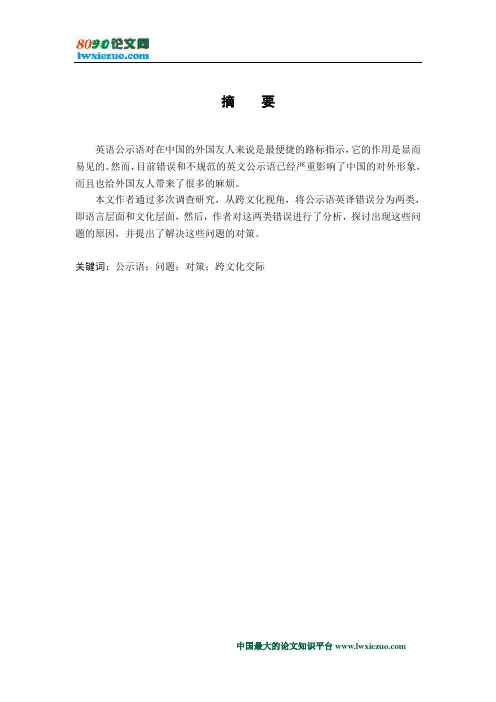
摘要英语公示语对在中国的外国友人来说是最便捷的路标指示,它的作用是显而易见的。
然而,目前错误和不规范的英文公示语已经严重影响了中国的对外形象,而且也给外国友人带来了很多的麻烦。
本文作者通过多次调查研究,从跨文化视角,将公示语英译错误分为两类,即语言层面和文化层面,然后,作者对这两类错误进行了分析,探讨出现这些问题的原因,并提出了解决这些问题的对策。
关键词:公示语;问题;对策;跨文化交际ABSTRACTEnglish public signs as the simplest guide are apparently essential to foreigners in China. However, the improper and nonstandard English public signs have been a pressing problem because they have defaced China’s International image and have given much trouble to the foreigners in their daily life.On the basis of many researches, the author classifies the public signs translation errors from linguistic and cultural aspects, analyses these two types of errors, illustrates the causes, and puts forward some strategies for improvements of public signs translation, from the perspective of intercultural communication.Key words:public signs; problems; strategies; intercultural communicationContents1.Introduction (51)2. An Overview of Public Signs (52)2.1 The Definition of Public Signs (52)2.2 Functions of Public Signs (53)2.3 Types of Public Signs (54)3. Intercultural Communication (56)3.1 Definition of IC (56)3.2 Language and Culture (56)3.3Application of IC to Translation of Public Signs (57)4. Problems of Public Signs C-E Translation and Analysis of Causes (59)4.1 Problems on Linguistic Level (59)4.2 Problems on Cultural Level (62)4.3 Causes Analysis (64)5. Strategies of Public Signs Translation (65)5.1Literal Translation (65)5.2 Liberal Translation (66)5.3 Addition and Omitting (67)6.Conclusion (69)Acknowledgements (70)References (71)1.IntroductionIn 2008, China held the Beijing Olympic Game successfully, and now the 2010 World Expo is being held in Shanghai. At present, more and more foreigners stream into China. They come to China to travel, study, and do business, etc. Most of them speak English instead of Chinese. Under such circumstances, English Public signs will play a very important role, because these signs will help foreigners to find their way in a new environment or get the information they want. However,the improper and nonstandard English public signs have been a pressing problem because they have defaced China’s international image and have given rise to troubles and inconvenience to the foreigners in their daily life. So it is very necessary to carry on the following error research on English translation of public signs. Many essays about this research have been published on many journals. However, most essays in these journals only discuss the problem from a special perspective and there has not been a thorough and systematic study of the distribution of error frequency and the causes of the errors on C-E sign translation so far. Therefore, this thesis intends to conduct a study of the translation of public signs with the aim to explore the strategies and methods to enhance public sign translation. And it will mainly focus on the following three parts: the application of intercultural communication to public signs; the error analysis on English translation of public signs and strategies for improvement.2. An Overview of Public Signs2.1 The Definition of Public SignsWhen we discuss the definition of “public signs”, it is necessary to clarify the definition of “sign”, in the English language first. The research of public sign was started in 1959 by two scholars named Vinay and Darbelnet from western country[1]424. According to Oxford English Dictionary , “sign” refers to a characteristic device attached to, or placed in front of, an inn or a store, as a means of distinguishing it from others or direct attention to it. In Webster’s Third International Dictionary, “sign”is defined as a lettered board or other public display placed before or on a building, room, store or office to advertise business there transacted or the name of person or firm conducting it [2]. From American Heritage Dictionary of the English Language,“sign” is defined as “a board, a post, or place displayed in a public place to convey information or a direction.” [3]While in China, it is in recent years that the expression of public signs comes into our view. In its literal meaning, public sign refers to the words or expression shown to the public in public places. Dai Zongxian & Lu Hefa[3] put forward the definition of “public signs” as “public display of written message bearing a designation, direction and other closely related literal and graphical information.” Prof. Lu Hefa has also classified the scope of signs in China in his dictionary A Chinese-English Dictionary on Signs[4]. According to him, public signs are very commonly used in people’s social life. In a word, the information, which is open to the public and related to their daily life, will be within the scope of researches on public signs. A public sign refers to a language-based message carrier used in public places to inform the public what they are supposed to know. The public signs are widely used in many fields and impact every aspect of our daily life. Therefore, the translation of public signs is ofgreat significance.2.2 Functions of Public SignsPublic signs are widely used and serve different functions for normal operation of the society. According to Professor Lu Hefa[5]38, public signs may fall into the following four categories in terms of function, namely directing, prompting, restricting and compelling. The different functions of the public signs directly affect the style and the mood of the translation.(1) DirectingBasically speaking, public signs serving directing function are information providers and the purpose is to give readers guidance about the service that they are entitled to. They are prevailing in a city and can be found almost everywhere. Examples as follows:问询服务Information售票处Ticket Office外卖Take Away营业时间Business Hours(2) PromptingPublic signs of prompting remind people to pay attention to them. Prompting signs are similar to the directive ones in their informative function. They are widely used on public occasions and often use brief and euphemistic words as well as different forms of sentences structures. For example:油漆未干Wet Paint向左急转弯Abrupt Turn Left减价销售On Sale道路封闭Road Closed(3) RestrictingNot as the two functions mention above, the function of restriction put constrains and restrictions to the readers. The purpose of public signs in this category is to confine the activities or actions of the related public with the special words. The languages are direct and simple, but the readers don’t feel these signs are impolite or rude. Look at the following:凭票入场Ticket Only慢速驶出Slow Out游客止步Staff Only限停车10分钟10 Minutes Parking(4) CompellingPublic signs of this type have a more tough tone than those with other three functions. They require readers to take or not to take certain actions, usually with direct tough, forceful language. And the language is supposed to bear no compromise.严禁乱扔垃圾No Littering不得进入草地Keep Off the Grass禁止酒后开车No Driving after Drinking禁酒区Alcohol Free ZoneAbove are the four functions of public signs. Chinese and English public signs have the same functions and express specific information.2.3 Types of Public SignsPublic signs can be found very easily around us. They are displayed in different places for different usages and functions. According to the places they placed, the author divides them into the following types.(1). Public Signs for Traffic and RoadTraffic and road signs are used to provide help for people and keep a good social order as well. These signs are playing a very important role in the society, especially in crowded places.(2).Public Signs for TourismMany public signs are placed at scenic spots. Some of them are used to remind the visitors to abide by some rules while others are to help them further understand the history or culture.(3).Public Signs for Service Industry and BusinessWith the development of economy, there are more and more public signs appear in the field of business and service industry. Many signs put on the window or at the door can easily attract consumers from both at home andabroad.(4). Public Signs for Environmental ProtectionNowadays, the situation of environment is getting worse and worse among the whole world. Public signs as one of the communication materials, perform not only the function of publicizing, but also a kind of “High Touch” service[6]26. That’s to say, public signs for environmental protection help to call for people to be self-discipline in protecting our environment.From the above we can see that public signs are widely used in people’s daily life. They can be found in every kind of public places. They are easy to remember and their four functions determine the language styles.3. Intercultural CommunicationIt is quite clear that C-E translation of public signs is closely related with Chinese and English. So bilingualism has always been regarded as an essential requirement for the translator. In fact, the activity of translation is a kind of intercultural communication. In Nida’s opinion, the most serious mistakes in translation are usually made not because of verbal inadequacy, but of wrong cultural assumptions[7]. Therefore, it is a must for translators to know some about intercultural communication.3.1 Definition of ICIt is clear that IC refers to the communication among people from two or more cultures. Successful IC is based on the positive feeling and beliefs we bring to the intercultural encounter and on the behavioral skills we possess. Professor Jia Yuxin[8]23thinks that the intercultural communication is the communication between people from different cultural backgrounds. Hanvey[9] believes that the sense of IC is the sensitive recognition of cultural factors between joiners during their communication.Language can not exist without culture. Naturally, in the course of intercultural communication, the participant or the translator should not only be familiar with his own language and culture, but also the language and culture of his counterpart, especially the differences between the two involved cultures[10].Only when he keeps these cultural factors in mind can he be competent in the process of intercultural communication.3.2 Language and CultureThe relationship between language and culture has been studied for many decades. Brown, H.D describes the two like this: “A language is a part of a culture and a culture is a part of a language; the two are intricately interwovenso that one cannot separate the two without losing the significance of either language or culture.”[11]56 Language is a bridge people can use to learn or understand cultural values and it is necessary to know cultural values to acquire the language to portray them. Language is a very important component of the culture. In fact, language is decided and restricted by the culture. Culture can have a great effect on the existence and development of language in many aspects.Therefore, in order to communicate effectively and competently across cultures we need to be aware of both linguistic and cultural knowledge at the same time. It is also suitable to PS translation, since this specific translation task is involved with both two different languages and cultures. If we want to have correct and idiomatic English public signs, we should not only be bilingual, but also be bicultural.3.3Application of IC to Translation of Public SignsPublic signs translation is an activity of intercultural communication, that’s to say the intercultural awareness is a must for translators when translating public signs into English. Just as Nida has put: to be bilingual, one has to be bicultural[12]. Cultural approaches consider translation as a communicative process which appears between cultures[13]27. Concerning public signs translation, the translators should focus on differences between the characteristic of Chinese and English language. It is true that cultural discrepancy is an important factor in the course of C-E translation of public signs.In addition, public signs translators should take readers’response as an important criterion in the assessment of translated version. Since these readers are mainly foreign visitors and tourists who know little about the history and culture of about China. It is true that many problems and errors in public signs translation are caused by the insufficient intercultural awareness. Some translators are deeply influenced by their mother tongue, which is a big problem when translating Chinese public signs into English. To solve the problem, public sign translators should correctly express the meanings of Chinese PSs in accordance with the idiomatic expressions of the target language when doing PStranslation. In this way, our translated versions can be better and more easily understood by target readers. It is evident that failure of IC in this specific translation task will undoubtedly lead to the occurrences of many mistaken and obscure English versions of Chinese PSs.4. Problems of Public Signs C-E Translation andAnalysis of CausesNowadays, a variety of international events are held in China, with an increasing number of foreigners coming here. English as the universal language of the world, becomes the most convenient tool of our communication. Although experts have called for more attention on the translation of public signs, and the present situation is far from being satisfactory. Ni Chuanbin and Liu Zhi[14]19published the paper Translation Principles for Public Signs and Example Analysis in which the authors put forward five principles. After that, there are many papers about translation of public signs appearing in some journals, but most of them didn’t form syste matical research. On the next part we will discuss the problems on the translation of public signs from linguistic and cultural aspect, and then analyse the causes.4.1 Problems on Linguistic LevelThe errors of linguistic translation are often due to deficiencies in the translator’s source or target competence. He Ziran ever explained that by making linguistic errors, the translators or interpreters fail to conform to the target language structure, instead they casually translate the source text in their own language structures.4.1.1 MisspellingThe most commonly encountered problems in the C-E translation of public signs are undoubtedly the spelling mistakes or misspelling. Errors of this kind are easily noticeable, but they are intolerable to English readers because they leave a bad impression to foreigners on the English proficiency of Chinese people. Such mistakes can be found everywhere, for example:(1) Ants and Crafts(工艺品)You may feel confused by this phrase if you are not on the spot and see the real objects with your own eye. It is put before the arts and crafts department in a sale stall in Nanjing Airport. It should be Arts and Crafts.(2) We may be surprised to see such an expression “Read End Collision”on a super highway, with the original meaning “追尾危险”. This public sign is very common and essential on super highways to warn drivers against accidents and keep the traffic order. However, the word “Rear” is mistaken for “Read”, and with no doubt it loses the intended meaning.In real life, spelling mistakes take up a lot in the overall translation problems of public signs. We may think that the translators should be responsible for them. Some may lack professional competence or may be because of their carelessness. Also the printers or makers of the public signs should be responsible for the problems.4.1.2 Grammatical ErrorsSentences in a good translation should, at least conform to the grammatical rules or conversations of target language. And it is particularly true for the translation of public signs. However, a lot of grammatical problems can be found in the translation of public signs. Most of these errors are not that visible as misspelling, but they also show the poor proficiency of the translator and their irresponsible attitude.Example 1: The International Building in Guangzhou, which is the tallest in China and also the symbol of Guangzhou city. It should stand for China’s international image. However, one of the signs on the International Building goes like: “加强国际交流合作,让世界了解广州”. The translation is: “International Exchange and Cooperation Facilitate Development of Guangzhou into International Metropolis!”It’s quite difficult for foreigners to understand. Due to the grammar problems, this sign could hardly play the role of building up an international city image. It is suggested to be translated as: “Facility the Development of Guangzhou into an International Metropolis through International Exchange and Cooperation!”Example 2: “通往下层” is translated into “To the below floor” on a certain street in Nanjing. The English version is grammatically wrong because the word “below” is a preposition instead of an adjective. Therefore, the English version should be “To the lower floor”.Example 3: “请保护环境卫生” is translated into “Please keep environment sanitation”, which has big grammatical problems. In terms of the sentencestructure, it is obvious that the word of “environment” is the object of the verb of “keep” and the word of “sanitation” is the object complement. According to English grammar, there exists a logical subject-predicate relationship between the object and its complement. So this sentence should be translated into “Please keep the place clean and tidy.”4.1.3 Words Improperly UsedA famous translator ever said that the proper words should be in the proper places in the translation. If not, errors might happen. The so-called “using improper words” shows that the translator does not fully understand the original public signs, and just makes a literal translation, which makes people puzzled.Example 1: 敬老院——Old Man’ HouseTo respect the aged and love the young are always the traditional virtues of China. In western countries, people do not like somebody else to say that they are old. So this pubic sign should be translated into “Senior Citizens’ House”.Example 2: 客户服务中心——Client Ministrant Centre“Ministrant”, as an adjective, is very formal and seldom used, meaning serving attendance. So it is not proper here, and we can use a very simple word “service” to replace it. It can be translated into “Customer Service Centre”.Example 3: 请勿停车使用——No Occupying While StablingThe revised English version should be No Occupying While Stationary. We can always find the above example on the toilet doors on trains. Here the word “stabling” is misused for it means “space in stables (a building for keeping and feeding horses in)”.In the translation of public signs, poor choice of words can be easily found. It is a very serious problem to choose wrong words. It shows the poor capability of the translators. Each word, when used in a new context, is a new word [15]251.A word is the smallest unit of language on its own, and the meaning is the most essential aspect of a word. So words should be chosen on the basis of accurate understanding of them.4.2 Problems on Cultural LevelApart from mistakes on the linguistic level, the mistranslation concerning culture also needs attentive study. Translation involves the transfer of two cultures as well as that of two languages, and that translation is regarded as a cultural communication to transplant the source culture. It is not an easy task to translate between Chinese and English because the two languages belong to entirely different cultural traditions. So translation is the intercultural communication between the western and Chinese cultures.To some extent, linguistic mistranslation is more tolerable to target readers in comparison to the mistranslation on the cultural level. Translation mistakes on the cultural level may make foreigners feel they are offended in such fields as customs, beliefs and faith. Therefore, mistranslation resulting from cultural ignorance is a problem that needs urgent solution, otherwise, China will be regarded as a country in the lack of cultural respect to others.Generally speaking, mistranslation from the perspective of culture can be classified into two categories: Chinglish and Inappropriate tone.4.2.1 ChinglishChinglish translations always come from the word-for-word translation method, which results from either the translators using such translation tools as dictionaries and translation machines or their lack of proficiency in translation. Chinese and English-speaking people have different thought patterns and accordingly different ways to express ideas. If these differences are ignored, it’s very easy to produce Chinglish.Example 1:请勿乱扔杂物——No Throws TrashThis public sign is widely used, especially in tourist attractions. But the translation is far from being satisfactory. It is apparently affected by Chinese pattern of thinking and it is typical Chinglish. The revised version is “No Littering”.Example 2: 不得在停车场内随地吐痰、大小便——Spitting, going convenient around must be prohibited.There is no such phrase as “going convenient around” in English. It might be an absurd word for word translation of “随地大小便”as in Chinese, “goaround”means “随地”and “convenient”means “方便”.Chinglish like this makes target readers who don’t speak Chinese puzzle or may laugh. A suggest version is “Spitting, urinating or defecating must be prohibited”.Example 3:一次性用品——A Time Sex ThingWhat will foreigners feel when they see signs with such filthy words? The translation is different from the original meaning. “一次性”means it can be used once only, but the translation not only twists the Chinese meaning, but also becomes an international joke. We can translate it into “Disposable Articles”.The following are more examples about Chinglish.Wrong Correct游客止步Consumers Stop Employee Only肉松Meat Pine Dried Meat Floss激情海岸Sex on the Beach Exotic Flavor买一赠一Buy one, give one Buy one, get one free英语之窗The Window of English English Service AvailableThe examples similar to those mentioned above are too numerous to show one by one. It can be said that the phenomenon of Chinglish is caused by translating Chinese according to the superficial Chinese meaning. And the translators didn’t pay attention to the differences between Chinese and English. They may impose the Chinese thinking model on the English version.4.2.2 Inappropriate ToneTo some degree, the tone decides what the additional function a public sign assumes besides the most fundamental one. Therefore, when translating public signs, we should not only translate the exact meaning but also the exact tone so that we could achieve functional equivalence in an overall way. But in most cases, equivalence in tone is always lost due to cultural misunderstanding.Example1: “青草依依,踏之何忍” can now be seen in many public places. Different from “请勿践踏草坪” which was often classified as a compelling sign in the public in the past, the former is more vivid and polite in tone because of personification used to express the meaning from the view the grass that we should protect. “Keep off the Grass”is the general translation, but the translation of “The Grass So Fair, Needs Your Care”put forward by Wu Weixiong[16]36 in 2004 is strongly recommended according to Nida’s functionalequivalence.Example 2: “请勿在此吸烟” This public sign is always translated into “No Smoking”which also violates Nida’s functional equivalence. The appropriate one is “Thank You for Not Smoking Here”From the discussion above, we can see that different cultures have different views of the same things, and errors will arise in the process of translation if those differences are overlooked by the translators. So translators should have a good command of cultural traditions of western countries.4.3 Causes AnalysisAs mentioned above, there are mainly two types of mistakes in Chinese-English public signs translation: translation errors on linguistic level and on cultural level. It may be due to translator’s carelessness such as spelling; it may also be due to translator’s low proficiency such as grammar errors. To solve those linguistic mistakes, translator needs to be both proficient and careful. In some cases, even if fully understanding the meaning of the original Chinese expressions, some translators may feel it difficult to find proper English words to replace the Chinese ones, and just use some words apparently seeming to be equivalent to the Chinese ones.For another thing, more and more new public signs appear nowadays. And these public signs have their own special characteristics. So it’s quite hard for the translator to express the English version correctly. The lack in the language competence was and still is a universal problem in the translation of pubic signs.Thirdly, with the development of science and technology, many signs are translated by computer software. In fact, it is very good to use computer as a reference. However, if we just rely on computer, the translation must have many problems.5. Strategies of Public Signs Translation5.1Literal TranslationLiteral translation is correct and must not be avoided, if it secures pragmatic equivalence to the original[17]. But literal translation is not word-for–word and one-to-one translations. Literal translation renders both the style and content of the original, and it also retains the original cultural information. Literal translation is widely used in translation of informative public signs which requires the accurate transfer of the original information.Example 1: 平等,发展,和平——Equality, Development, Peace.Example 2: 整个景区占地约8000平方米,以排云殿为中心,由排云殿、宝华殿、云锦殿、二宫门、芳辉殿、紫霄殿、德辉殿以及连通各座殿堂的游廊、配房组成(The Summer Palace)——The entire scenery area covers an area of 8000 square metres, with Paiyun Dian at the center, surrounded by Paiyun Men, Yuhua Dian, Yunjin Dian, Er Gong Men, Fanghui Dian, ZixiaoDian. Dehui Dian, all of which are linked by corridors and side halls.Information of the source texts are all maintained. Sentence orders remain unchanged in the translations. Even the target texts take the similar styles of the source text. The transfer of content must be put to priority. For informative public signs, literal translation can best reserve the original content.5.2 Liberal TranslationLiberal translation mainly conveys the meaning and spirit of the original without remaining the sentence patterns or figures of speech. Liberal translation echoes with Peter Newmark’s communicative translation. Liberal translation is the main strategy used in translation of evocative public signs. As discussed above, for evocative public signs, the focus of attention of the Chinese readers and that of the English readers are quite different. In this case, a liberal method is preferred.Example 1:…是当年慈禧到佛香阁拈香礼佛时的更衣之处(The Summer Palace)——It served as a dressing room for Empress Dowager Cixi on her way to the Tower of the Fragrant of the Buddha to pay her homage. Functionally speaking, this sentence is an informative one. Compared with “pay homage to the Buddha”, “burn incense”is less important information. The target text, although not completely transfer the original content, functions the same as the source text.Example 2:…高度体现了中国园林“虽由人作,宛自天开”的造园准则.(The Summer Palace)——…That best illustrates the guiding principle of traditional Chinese garden design: “the works of men should match the works of Heaven”.As a matter of fact, the adoption of literal and liberal translation in the C-E translation is quite flexible. Sometimes, the combination of the two methods of translation is also visible. However, just as Nord said that “ends justify means”, the actual functional purpose of a sign should always be the No 1 priority in the translation public signs. And the text type of a specific sign should also be taken into consideration.。
1.IN 向内
2.OUT 向外
3.ENTRANCE 入口
4.EXIT 出口
5.DOMESTIC ARRIV ALS (DEPARTURES) 国内航班抵达(出站)
6.INTERNATIONAL ARRIV ALS(DEPARTURES) 国际航班抵达(出站)
7.BAGGAGE CHECK-IN 行李登记
8.CUSTOMS海关
9.SECURITY CHECK安全检查
10.BAGGAE CLAIM行李认领
11.TRANSIT PASSENGERS过境旅客
12.NO PARKING DAY OR NIGHT 昼夜禁止停车
13.NO PARKING IN DRIVEW AY 机动车道禁止停车
14.AUTHORIZED CARS ONL Y 专用停车位
15.VEHICULAR ENTRY车辆入口
16.TRAFFIC ISLAND 交通岛(转盘)
17.ONE LANE BRIDGE 单道桥
18.FORM ONE LANE’并道
19.STEEP DESCENT陡坡慢行
20.STEEP CLIMB陡坡慢行
21.DIP下山
22.GRA V AL ROAD 砾石路
23.NO OVERTAKING ON BRIDGE 桥上禁止超车
24.NO U TURN 禁止掉头
25.NO RIGHT TURN 禁止右转弯
26.STOP HERE ON RED SIGNAL 红灯停车
27.DETOUR AHEAD 绕路向前
28.NO THOROUGHFARE 禁止通行
29.NO THROUGH ROAD 此路不通
30.PEDESTRIAN CROSSING AHEAD 注意前方人行道
31.PLEASE PAY CONDUCTOR 请向买票人付费
32.DO NOT SPEAK TO THE DRIVER WHILE THE BUS IS IN MOTION
33.PULL SIGNAL CORD ONCE WHEN APPROACHING THE STOP REQUIRED
34.RIDING ON PLATFORM PROHIBITED 严禁站台汽车
35.PLEASE PAY DRIVER 请向驾驶员付费
37.PLEASE PAY DRIVER 请向司机付费
38. STAND CLEAR INW ARD OPENING DOOR 车门向内开请勿靠近
39.PAY THE CORRECT FARE 正确付费
40.THERE ARE SEVERE PEALTIES FOR FARE EA VSION 逃避买票将受到惩罚
41.STA TE YOUR DESTINA TION WHEN PAYING YOUR FARE
买票时请说明你的目的地
42.PLEASE VACA TE THIS SEA T FOR A DISABLED PERSON IF REQUIRED
请主动给残疾人让座
42BOTTLE SHOP 瓶装酒经销店
43BOTTLE SERVICE 瓶装酒经销店
44BOTTLE SALES 瓶装酒经销店
45LIQUOR SHOP 白酒商店
46DOLLAR BOOKSHOP 一元书店
47DISPOSAL SHOP 清仓处理店
48DUTY FREE SHOP 免税商店
49USED CAR DEALER 二手车经销商
50PREOWNED CAR BROKER 旧车转让中间商
51X GOERMENT CARS FOR SALE
52BUTCHER 肉店
53BUTCHERY 肉店
54REAL ESTATE AGENTS 房产中介
55PAWN BROKER 典当行
56MONEY LENDER 放款人
57HAIR SALON 发廊
58HAIRDRESSING SALON 美发厅
59BARBER 理发店
60HAIR STYLISTS 美发屋
61BEAUTY PARLOR 美容院
62WATCHMAKER: QUALITY REPAIR 钟表精修
63FUNERAL DIRECTORS 殡仪员
64MOTOR FUNERALS 丧葬车出租店
65DRUM CITY—EVERYTHING MUSICAL 鼓城乐器大全
66LOCKSMITH 锁店
67FURNITURE CENTRE 家具城
68DOG SHOP 养狗用品商店
69TOY FISHERIES 渔具店
70AUTO SERVICES 汽车维修
71QUALITY BODY BEATING 车身精修
72SALE PRICE 特价
73CRAZY PRICE 疯狂大减价
74TERRIFIC VALUE 超值商品
75SPECIAL BUY 大甩卖
76INSTANT REPAIR 立等可取
77REPAIR WHILE U WAIT 即时修理立等可取
78SAME DAY SERVICE 当日维修服务
79HOURS FOR OPENNG AND CLOSING 开放时间
80DISCOUNT 折扣店
81NOT FOR SALE 非卖品
82SELF-SERVICE 自助
83OPEN 7 DAYS A WEEK 每周七天开放
84CUSTOMERS PLEASE REFRAIN FROM ENTERING THIS AREA 顾客请止步85NOT FOOD OR DRINKS TO BE BROUGHT IN SHOP 请不要把饮食带入商店
86UNATTENEDED CHILDREN NOT ALLOWED IN SHOP 无人照顾儿童谢绝进入商场87COME ON IN 顾客请进
88COME ON OUT 请出来
89COME ON DOWN 顾客请上楼
90FEEL FREE TO BROWSE AROUND
YOU’RE UNDER NO OBLIGATION TO BUY 只许参观浏览不许购买
94. THANK YOUR FOR YOUR CUSTOM 感谢惠顾
95. DO NOT LITTER无乱扔杂物
97. PLEASE KEEP THIS SITE BEAUTIFUL 请保持清洁
98. TAKE YOUR LITTER WITH YOU 请带走你的垃圾
99. PULLTION IS A MENACE TO US ALL 污染对人人有害
100. PLEASE DO NOT THROW PLASTIC AND PAPER RUBBISH INTO THIS RIVER.
请勿往河里投掷垃圾
101 FIRE CAN BE DANGEROUS 火灾危险
102 PLEASE DON’T DROP LIGHTED CIGARETTES AND MA TCHES 禁止烟火
103 NO RUNNING (ROUGH PLAY /SWEARING/CHEWING GUM/GLASS BOTTLES/DOGS OR ALCHOHOL) ALLOWED 请不要跑/大闹/骂人/吃口香糖/
104 . PRIV ATE PROPERTY KEEP OUT
TRESPASSERS WILL BE PROSECUTED 私人住宅请勿入内闯入者将法办
105 THS AREA IS OPEN FOR INSPECTION ONL Y 此区在检查时开放
106 PLEASE STOP请止步
NO ENTRANCE禁止入内
107 STAFFF ONL Y员工通道
108 PRIV ATE 私人专用
109 THE SALES SECTION STOPS HERE 非营业区
110 ADMITTANCE TO THIS AREA IS PROHIBITED 禁止入内
111 NO ADMITTANCE 闲人免进
112 POSITIVELY NO ADMITTANCE 严禁入内
113 TAKE YOUR HANDS OFF THE RAIL 请勿扶栏杆
114 THANK YOU FOR NOT SMOKING 请勿吸烟
115 DO NOT PROCEED BEYONG RAIL 请勿翻越栏杆
116 ANY DAMAGES OR BREAKEAGES MUST BE PAID FOR 损坏东西必须赔偿
117 IF IT BREAKS WE CONSIDER IT SOLD TO YOU 若有破损请负责赔偿
118 LOOK WITH YOUR EYES PLEASE DON’T TOUCH 请勿动手触摸
119 PHOTOGRAPHY INSIDE OLD GOVERNMENT HOUSE NOT PERMITTED 不准在古旧的政府大楼内拍照
120 NO ENTRY BY THIS DOOR 请勿走此门
121 PLEASE DO NOT LEA VE YOUR BELONGINGS HERE. 请勿放置个人物品
122 THE MAAGEMENT RESERVES THE RIGHT TO REFUSE ENTRY 管理人员有权谢绝入内
123PLEASE PUT ALL CARDS IN SHUTE SIT DOWN UNTIL CALLED 请用病例排队124NEXT TELLER PLEASE 请到其他窗口办理
125ISSUE OF LOANS 发放贷款
126RETURN OF LOANS 借款的偿付。